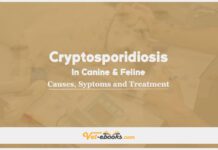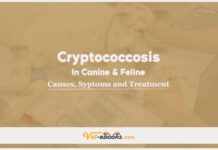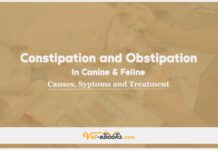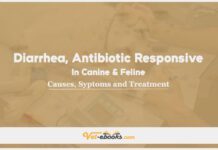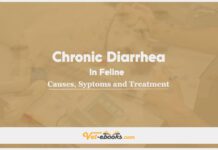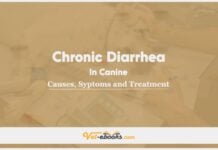Food Reactions (Gastrointestinal), Adverse In Canine and Feline: Causes, Symptoms and Treatment

Contents
hide
Overview
- Adverse food reactions cover a range of illnesses that can be classified into three main categories: immunologic, nonimmunologic, and toxic.
- Food intolerances are a mark of nonimmunologic reactions as opposed to food allergies.
- Lastly, toxic reactions are caused by food intoxication.
- Food allergy, food intolerance, and food intoxication exhibit the same symptoms, diagnostic methods, and treatment approaches, making it challenging to differentiate between them.
Causes of Food Reactions (Gastrointestinal), Adverse In Canine and Feline
Causes
- Idiosyncratic responses to several food additives, including colorings, preservatives (such as butylated hydroxyanisole, monosodium glutamate, sodium nitrate, sulfur dioxide, etc.), spices, and propylene glycol.
- Vasoactive chemicals like histamine, psychotropic drugs, and stimulants like theobromine and caffeine are all part of pharmacological reactions.
- In cases of gluten-sensitive enteropathy, metabolic flaws or deficiencies show up as brush-border enzyme deficiencies, like lactase deficiency, as well as inborn metabolic errors and aminopeptidase N deficiencies.
- Toxic reactions to foods or spoiled foods include many bad things, such as ergotism, botulism, oxalate toxicity, lectin toxicity, N-propyl disulfide aflatoxicosis, and eating too much of certain things.
- Genetic mutations in genes associated with innate immunity regulate the host’s reactions to dietary components.
Risk factors
- Increased likelihood of young Irish setters who are vulnerable to gluten-sensitive enteropathy getting the condition if they are exposed to gluten during their early stages of life.
- Probable association between host genetic susceptibility and the occurrence of certain health conditions in wheaten terriers and German shepherd dogs.
Pathogenesis of Food Reactions (Gastrointestinal), Adverse In Canine and Feline
- Food allergies are caused by complicated immune system processes, a damaged intestinal mucosal barrier, messed-up immune responses, and a decreased ability to handle oral intake.
- The majority of food allergies arise from type 1 hypersensitivity reactions.
- The primary food allergens encompass dairy, poultry, and meat products such as milk, eggs, cattle, and chicken, as well as plant-derived proteins derived from corn, wheat, and soybeans.
- Food intolerance can result from a variety of factors, including animal responses to dietary additions or components, pharmacological reactions to chemicals in the diet, metabolic pathways that are absent or not functioning properly and are necessary to use food, toxic reactions to food ingredients, or contaminated food items.
- In contrast to food allergies, food intolerance does not necessitate prior exposure to a specific food item.
- Toxic reactions to food manifest when an animal consumes a substantial quantity of a particular food item, such as in the case of onion poisoning.
- Toxic reactions arise from the presence of toxins, such as aflatoxin, a hepatotoxin produced by Aspergillus spp., or from the spoilage or bacterial contamination of food.
Symptoms (History & Physical Examination) of Food Reactions (Gastrointestinal), Adverse In Canine and Feline
History
- Acute food intolerance might occur while introducing a new food item, adopting a different food source, or making alterations to the diet.
- Clients may observe the cessation of clinical indications when the patient is in a fasting condition or within a few days of doing an elimination diet trial.
Physical Examination
The physical examination is typically generic; nevertheless, it may reveal gastrointestinal discomfort, flatulence, bloating, or localized patches of hair loss on the ears and around the eyes, particularly in felines.
Diagnosis of Food Reactions (Gastrointestinal), Adverse In Canine and Feline
1- From History and Physical Examination
2- Diagnostic Procedures
CBC/BIOCHEMISTRY/URINALYSIS
- Frequent routine screenings to identify worsening conditions or differential diagnoses, such as hypoalbuminemia or indications of hypoadrenocorticism.
- Eosinophilia may occasionally manifest in animals with food allergies.
OTHER LABORATORY TESTS
- Serum cobalamin and folate levels to assess the extent of involvement in both the proximal and distal small intestines and to identify potential requirements for supplementation.
- Trypsin-like immunoreactivity to diagnose EPI.
- A baseline cortisol or adrenocorticotropic hormone stimulation test to eliminate the possibility of hypoadrenocorticism if there are clinical suspicions.
- Total T4 in cats to assess hyperthyroidism when there are clinical indications suggesting its occurrence.
- Fecal alpha-1 proteinase inhibitor test in cases where there is a suspicion of PLE but other laboratory findings are inconclusive or there is concurrent proteinuria.
- The test for perinuclear antineutrophilic cytoplasmic autoantibodies is currently restricted to research settings. One area where it has shown promise is in finding PLE and PLN early on in soft-coated wheaten terriers, which is often a sign of a food allergy.
- Distinguish between canines exhibiting diet-responsive enteropathies and those that need glucocorticoid treatment for enteropathies.
- To enhance sensitivity, conduct 2-3 tests of fecal flotation and fecal smear over a span of multiple days.
- As a way to deal with possible cases of undiagnosed parasitic infections, empirical deworming using a broad-spectrum anthelminthic could be thought about.
Imaging
- Abdominal radiography or ultrasonography to exclude potential differential diagnoses.
- Doppler examination using ultrasound to identify changes in blood flow within the celiac and cranial mesenteric arteries of canines.
Elimination diet trial
- For 2 weeks in cats and 3 weeks in dogs presenting gastrointestinal symptoms.
- After seeing positive results, proceed with challenge exposure to patient items in a sequential manner.
- This aims to accurately identify the exact food component that causes adverse effects.
- Although considered the gold standard in theory, applying this approach is sometimes seen as impractical within a clinical context.
- To prevent clinical relapse, engage in exclusive feeding with a hydrolyzed or new protein source for an extended period of time.
- Urinalysis and measuring urine protein: creatinine ratio (if necessary) in diet-responsive wheaten terriers to assess for potential glomerular damage accompanied by urinary protein loss.
3- Differential Diagnosis
- Infectious diseases (intestinal nematodes, Giardia, histoplasmosis, salmonellosis, toxoplasmosis (cats), feline infectious peritonitis).
- Infiltrative GI diseases (IBD, histiocytic ulcerative colitis in boxers and French bulldogs).
- Endocrine diseases (hypoadrenocorticism, hyperthyroidism (cats)).
- EPI.
- Lymphangiectasia.
- GI motility disorders.
- Pancreatitis.
- Metabolic diseases (renal disease, liver disease).
Treatment of Food Reactions (Gastrointestinal), Adverse In Canine and Feline
General:
- The implementation of lifelong nutritional control is important for animals suffering from food intolerance and food allergy.
- For an exclusion diet experiment, use a veterinary prescription hydrolyzed protein diet, a commercially available novel protein diet, or make your own novel protein diet.
- These protein sources are chosen based on a thorough assessment of the animal’s nutritional background.
- If animals have food allergies, choose veterinarian-prescribed products that are specifically formulated for such conditions.
- Home-prepared novel protein diets elicit a favorable reaction in animals that did not exhibit a response to a commercially available diet containing the same protein.
Medications:
No medications are used.
Some Notes:
- Hydrolyzed protein diets are formulated through the process of enzymatic hydrolysis, which involves breaking down the whole protein into smaller peptides.
- This enzymatic hydrolysis reduces the likelihood of the protein triggering an allergic reaction.
- Hydrolyzed diets are considered optimal in cases where an animal has been subjected to a wide range of protein sources or when a comprehensive dietary history cannot be confirmed.
- Hydrolyzed protein diets have the potential to maintain a certain level of antigenicity.
- Ideally, the original protein used in the hydrolyzed diet should be one that the animal does not have a documented sensitivity to.
- Hydrolyzed protein diets have the potential to provide benefits to animals that do not have a genuine food allergy, mostly due to the enhanced digestibility of the diet.
Tip
Do You Want To Increase Your Veterinary Knowledge and Practical Skills?
You Can Now Browse and Download +3000 Books For Veterinary Professionals & Students Online.
Download Veterinary Books

